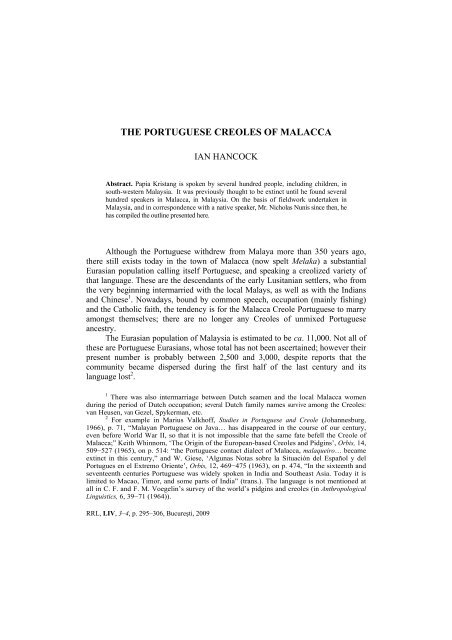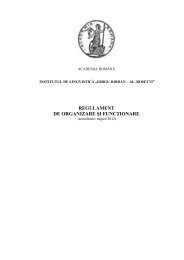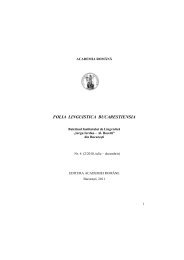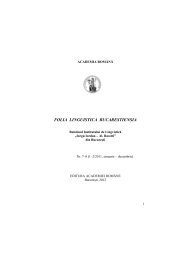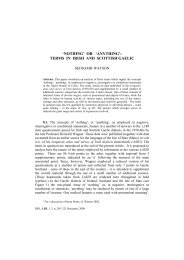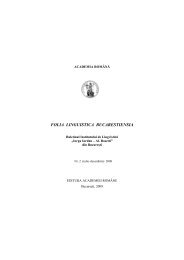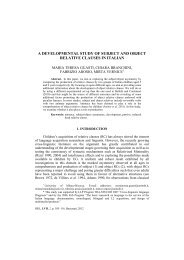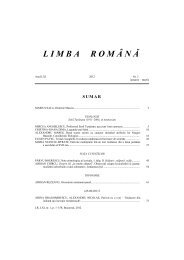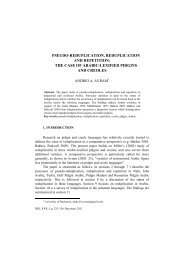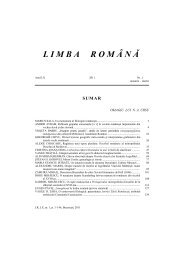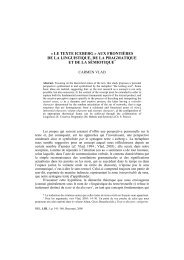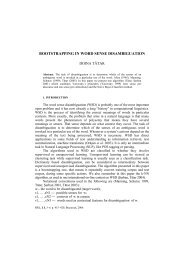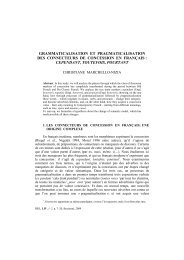You also want an ePaper? Increase the reach of your titles
YUMPU automatically turns print PDFs into web optimized ePapers that Google loves.
<strong>THE</strong> <strong>PORTUGUESE</strong> <strong>CREOLES</strong> <strong>OF</strong> <strong>MALACCA</strong><br />
IAN HANCOCK<br />
Abstract. Papia Kristang is spoken by several hundred people, including children, in<br />
south-western Malaysia. It was previously thought to be extinct until he found several<br />
hundred speakers in Malacca, in Malaysia. On the basis of fieldwork undertaken in<br />
Malaysia, and in correspondence with a native speaker, Mr. Nicholas Nunis since then, he<br />
has compiled the outline presented here.<br />
Although the Portuguese withdrew from Malaya more than 350 years ago,<br />
there still exists today in the town of Malacca (now spelt Melaka) a substantial<br />
Eurasian population calling itself Portuguese, and speaking a creolized variety of<br />
that language. These are the descendants of the early Lusitanian settlers, who from<br />
the very beginning intermarried with the local Malays, as well as with the Indians<br />
and Chinese 1 . Nowadays, bound by common speech, occupation (mainly fishing)<br />
and the Catholic faith, the tendency is for the Malacca Creole Portuguese to marry<br />
amongst themselves; there are no longer any Creoles of unmixed Portuguese<br />
ancestry.<br />
The Eurasian population of Malaysia is estimated to be ca. 11,000. Not all of<br />
these are Portuguese Eurasians, whose total has not been ascertained; however their<br />
present number is probably between 2,500 and 3,000, despite reports that the<br />
community became dispersed during the first half of the last century and its<br />
language lost 2 .<br />
1 There was also intermarriage between Dutch seamen and the local Malacca women<br />
during the period of Dutch occupation; several Dutch family names survive among the Creoles:<br />
van Heusen, van Gezel, Spykerman, etc.<br />
2 For example in Marius Valkhoff, Studies in Portuguese and Creole (Johannesburg,<br />
1966), p. 71, “Malayan Portuguese on Java… has disappeared in the course of our century,<br />
even before World War II, so that it is not impossible that the same fate befell the Creole of<br />
Malacca;” Keith Whinnom, ‘The Origin of the European-based Creoles and Pidgins’, Orbis, 14,<br />
509−527 (1965), on p. 514: “the Portuguese contact dialect of Malacca, malaqueiro… became<br />
extinct in this century,” and W. Giese, ‘Algunas Notas sobre la Situación del Español y del<br />
Portugues en el Extremo Oriente’, Orbis, 12, 469−475 (1963), on p. 474, “In the sixteenth and<br />
seventeenth centuries Portuguese was widely spoken in India and Southeast Asia. Today it is<br />
limited to Macao, Timor, and some parts of India” (trans.). The language is not mentioned at<br />
all in C. F. and F. M. Voegelin’s survey of the world’s pidgins and creoles (in Anthropological<br />
Linguistics, 6, 39−71 (1964)).<br />
RRL, LIV, 3–4, p. 295–306, Bucureşti, 2009
296<br />
Ian Hancock<br />
On August 1 st 1509 five Portuguese ships landed at Malacca under the<br />
command of Admiral Diogo Lopes de Sequeira. This was the first instance of<br />
contact between Europeans and the inhabitants of the Malay Peninsula. Initial<br />
friendliness on the part of the local population soon gave way to hostility and<br />
mistrust − a state of affairs which, due to cruel treatment by the Portuguese, was to<br />
remain for the whole period of their occupation of the area. In 1511 the nobleman<br />
Alfonso de Albuquerque landed at Malacca with 19 ships, the crew comprised of<br />
800 Portuguese and 600 Indian soldiers. They stayed three months and erected a<br />
fort − a fort so well constructed that despite its having been attacked 20 times<br />
during a period of over 120 years, not once was it ever taken. At this time, Malacca<br />
had a population of some 20,000, of whom about one third were Portuguese or of<br />
Portuguese stock. The town welcomed vessels of all nations (excepting Arab<br />
ships), and from their base there the Portuguese continued their exploration of the<br />
Far East.<br />
In 1580 Portugal became part of the Spanish Empire under Philip II, but<br />
despite added naval strength from the Spaniards they were not sufficiently<br />
powerful to keep the Dutch, who also had interests in the East and with whom they<br />
were now at war, at bay. The Portuguese were defeated in two sea battles (1606<br />
and 1608) in the Straits of Malacca, although at this time the town itself had not yet<br />
been taken. In 1635 the Dutch started regular patrols in the Straits, in order to<br />
waylay all ships entering and leaving Malacca. In a few years the town had become<br />
so weak that it was quite vulnerable to attack; consequently in July, 1640 2,000<br />
Dutch soldiers landed there and starved the Portuguese out. The latter eventually<br />
surrendered on December 1 st that same year. They were not, however, massacred,<br />
but allowed to leave quickly and settle in other Portuguese colonies in the East<br />
such as Goa and Diu. Only a handful of Portuguese and Portuguese Eurasians were<br />
left in Malacca.<br />
The Dutch held the town until 1795, a period of 155 years. Under them it did<br />
not prosper, and by the end of their rule the population had decreased to 15,000.<br />
The British took over in 1795, but the Dutch returned in 1818 in an attempt to<br />
re-establish their trade In the area. In 1824 however, a treaty was drawn up<br />
between the Dutch and the British whereby Singapore and the Malay Peninsula<br />
was to come under British rule, and the island of Riau (earlier spelt Rhio or Rhiow,<br />
and also known as Pulau Bintang) was to go to the Dutch. The whole of Malaya<br />
remained a British colony until independence − Mĕrdeka − in 1957 when it was<br />
renamed Malaysia.<br />
In English, the Malacca Creoles call their language Portuguese; in their own<br />
language it is known as Papia Kristang (i.e. ‘Christian Speech’) or simply<br />
Kristang, by which name the Creoles also call themselves. In metropolitan<br />
Portuguese Papia Kristang has been called variously Malaqueiro, Malaquense,<br />
Malaques and Malaquenho, while in Malay, at least colloquially, it is sometimes
3 The Portuguese Creoles of Malacca 297<br />
rather disparagingly referred to as Bahasa Gĕragu 3 . It survives in two communities<br />
in the Malacca area, Trangkéră and the nearby so-called Portuguese Settlement, an<br />
area covering several acres fronting the sea, administered by the local Catholic<br />
church of St. Peter’s, and originally set aside for the Creoles many years ago by the<br />
then resident priest Father A. M. Coroado. Creoles still refer to the Settlement as<br />
the Chang di Padri or Padri să-Chang (i.e. ‘Priest’s Ground’) although its official<br />
name is Hilir (in Portuguese, Ilher). Papia Kristang also survives to a lesser extent<br />
in other Malaysian towns where Creoles have settled. According to Schuchardt, a<br />
Creole speaking community was established further north in earlier years on the<br />
Kedah coast 4 . There is no evidence of this today.<br />
Although the language is still fairly vigorously alive in Malacca, the tendency<br />
is for it to be employed less by those living outside the settlements. Children<br />
resulting from out-marriage do not as a rule learn Kristang unless they grow up in<br />
Malacca. It has traditionally not been written 5 , and at the present time no use is<br />
made of it in education, broadcasting, or the Church 6 .<br />
Papia Kristang has its origins in the early Portuguese lingua franca or “Low<br />
Portuguese” which probably originated in the fifteenth century on the West African<br />
coast. This trade contact language, itself possibly developing from the earlier<br />
Mediterranean Sabir 7 , was carried by Lusitanian seamen to the Near and Far East,<br />
and to Central and South America. Modern descendants of the Portuguese lingua<br />
franca survive in various parts of the world, more or less influenced structurally<br />
and lexically by the coexistent indigenous languages 8 .<br />
The dialect spoken in Malacca belongs to the Malayo-Portuguese subgroup<br />
of the Lusoasian (Portuguese lexifier) creoles, and is perhaps the most conservative<br />
of its existing members, having been out of contact with metropolitan Portuguese<br />
3 I.e. ‘Prawn Language’. Malay gĕragu or gĕragau (PK grágu) is the name of a type of<br />
prawn of which the Creoles are particularly fond. Equally disparaging is the Malay name<br />
applied to the population, viz. Orang Gĕragu, “prawn people.” More formally in that language<br />
the Creoles are referred to as Sĕrani “Christians”(< Nazarene).<br />
4<br />
See Hugo Schuchardt, Beiträge zur Kenntnis des Kreolischen; Romanisch V:<br />
Allgemeineres über das Indoportugiesische“, Zeitschrift für Roman. Philolog. XIII, 476−516,<br />
1889, p. 478.<br />
5 Except by isolated individuals, including linguists and Portuguese missionaries. The<br />
latter generally employ some modification of Portuguese orthography.<br />
6 At the time of writing, sermons are being given in Malacca in Macao Creole<br />
Portuguese by a visiting priest from that island. The older variety of Macao Creole is<br />
sufficiently similar to Papia Kristang to be intelligible. In contrast, until the government<br />
relocated them to other parts of the city, the Creole community in Singapore attended regular<br />
mass said in the mother tongue at their own church of St Joseph’s.<br />
7 See R.W. Thompson, ‘A Note on some Possible Affinities between the Creole Dialects<br />
of the Old World and those of the New’, Creole Language Studies, 2, 107−113 (1961).<br />
8 For a complete survey of these, see the writer’s ‘A Survey of the World’s Pidgin and<br />
Creole Languages’ (with map), in Dell Hymes (ed.), The Pidginization and Creolization of<br />
Languages (Cambridge University Press, 1975).
298<br />
Ian Hancock<br />
for over three and a half centuries. Despite this, the non-Portuguese derived lexical<br />
content of Papia Kristang is comparatively small.<br />
Other dialects belonging to the Malayo-Portuguese group include those of<br />
Singapore 9 , Korlai 10 , Macao 11 and Hong Kong 12 . In earlier years similar varieties<br />
were spoken in Djakarta, Tugu, Flores, Ceram and other East Indian communities,<br />
but today these have given way to Malay or other Indonesian languages. The socalled<br />
Malayo-Spanish languages of the Philippines have been shown to be a<br />
development from an earlier Malayo-Portuguese contact vernacular 13 .<br />
Less closely related to Papia Kristang are the Creole Portuguese dialects<br />
belonging to the Indo-Portuguese group, which were spoken in many towns along<br />
both coasts of India, and in Sri Lanka 14 . Indo-Portuguese once supported a<br />
flourishing literature − mostly of a religious nature − but today its speakers are few.<br />
It has nevertheless had considerable influence upon Malacca Creole since not only<br />
did it probably contribute to the formation of the Malayo-Portuguese dialects,<br />
which were established at a later period, but it has continued to exert a marginal<br />
influence upon it up to the present day due to limited social traffic between the two<br />
areas.<br />
The orthography employed here is based upon that currently used for Malay,<br />
with the exception that Malay e-breve (ĕ) for [ə] 15 is written /ă/. This has the<br />
advantage of being a spelling system with which most Papia Kristang speakers are<br />
already familiar, and may easily be used since the phonological systems of the two<br />
languages are broadly speaking identical.<br />
Papia Kristang has eight vowels, only six of which are contrastive 16 . These<br />
are /i/, /e/-/e/, /a/, /]/-/o/, /u/ and /ə/. For some speakers there is a certain amount of<br />
free variation between /i/ and /e/, and /o/ and /u/. Phonetically, /ə/ is articulated as a<br />
9 For specimens of Singapore Creole Portuguese, see Adolfo Coelho, “Os Dialectos<br />
Românicos ou Neolatinos na Africa, Asia e América’, Boletim da Soc. de Geografia de Lisboa, 2,<br />
129−196 (1880−1), 3, 451−478 (1882) and 6, 705−755 (1886). As in Malacca, this dialect is<br />
called Kristang.<br />
10 See J. C. Clements, The Genesis of a Language: The Formation and Development of Korlai<br />
Portuguese. Amsterdam: Benjamins, 1996.<br />
11 For an outline of Macao Creole Portuguese, see Graciete Batalha, “Estado Actual do<br />
Dialecto Macaense”, Revista Portuguesa da Filologia, 9, 177−213, 1959.<br />
12 See R. W., “O Dialecto Português de Hong Kong”, Boletim de Filologia, XIX,<br />
289−293 (1960).<br />
13 See Keith Whinnom, Spanish Contact Vernaculars in the Philippine Islands (Hong Kong<br />
University Press, 1956).<br />
14 See Dalgado, S.R., O Dialecto Indo-Português de Ceylão (Lisbon, 1900) and for<br />
Changes since then, Ian Russell Smith, Sri Lanka Creole Portuguese Phonology. Unpublished<br />
doctoral dissertation, Cornell University, 1977.<br />
15 In recent years the official Bahasa Melayu orthography has done away with the e-<br />
breve /ĕ/ symbol, employing only /e/.<br />
16 There are two words where (e) and (e) are contrastive, viz. pétu ([petu]), ‘chest,<br />
breast’, and pétu (['petu]), ‘near’ (Ptg. peito and perto).
5 The Portuguese Creoles of Malacca 299<br />
half-close back vowel with lip spreading, especially in final position; otherwise it is<br />
articulated in mid-central position.<br />
The consonants are /p/, /b/, /t/, /d/, /ch/,/j/, /k/, /g/, /f/, /s/, /z/, /m/, /n/, /ng/,<br />
/ny/, /l/, /r/, /w/ and /y/. Plosives are unaspirated in all positions, and /l/, /r/, /t/, /d/<br />
and /n/ tend to be slightly retroflexed, especially by elderly Creoles. As in Malay<br />
orthography, Papia Kristang /ng/ represents [ŋ] [ŋg] and [ŋk] being written <br />
and respectively: PK lúngă (['luŋə]), sángi (['saŋi]), ‘moon’, ‘blood’, ngkă<br />
(['ŋkə]), nggrátu ([ŋ'gratu]), ‘not’, ‘ungrateful’.<br />
Stress is marked by an acute accent in this outline, which would be<br />
unnecessary in general use: káză, kazá,’house’, ‘marry’, lábă, labá, ‘wash’, ‘bee’.<br />
The Papia Kristang vocabulary is derived from six main sources: Portuguese,<br />
Dutch, Malay, English, Chinese and Indian.<br />
By far the largest proportion of lexical items in the language is traceable to<br />
Portuguese, in most cases identifiable with the modern metropolitan language.<br />
Many words however derive from either archaic or dialect forms, e.g. PK arafíng,<br />
káinyu (‘conceit’, ‘miserly’). from archaic Portuguese arafim and cainho; modern<br />
Portuguese has vaidade and avaro − or PK étika (‘tuberculosis’), from a dialect<br />
variant hetica of Standard Ptg. tisica.<br />
Often the Papia Kristang items undergo change of meaning: PK bizáru for<br />
example, means ‘placid’ or ‘becalmed’, while its Ptg. source bizarro means<br />
‘elegant’. A number of words have been constructed from morphemes within the<br />
language, and differ from their Ptg. equivalent. PK skribáng (‘clerk’), for example,<br />
derives from PK skribé (‘write’, Ptg. escrever), while for the same item<br />
metropolitan Portuguese has empregado.<br />
The Dutch contribution to the lexicon amounts to about 30 words, examples<br />
of which include PK, atápăl (‘Irish potato’), Du. aardappel; kakús (‘latrine’), Du.<br />
kakhuis; kukís (‘cake’), Du. koekjes; kalkún (‘turkey’), Du. kalkoen; klor (‘colour’),<br />
Du. kleur (Ptg. côr); doi (‘money’), Du. duit (a farthing), &c.<br />
Malay words are constantly being adopted into the language, usually from the<br />
dialectal variety spoken in the State of Melaka. These are occasionally altered to<br />
conform with the syllabic structure of the Creole: PK kálu, ka (‘in’), Mal. kalau;<br />
alú (‘shoo away’), Mal. halau; champurá (‘mix’), Mal. champor; amóku<br />
(‘berserk’), Mal. amok, &c.<br />
As with Malay, the use of English-derived words in Papia Kristang is<br />
increasing. These too may become altered phonologically: PK ropiánu<br />
(‘European’, cf. Ptg. europeu); strétu (‘straight’); mótoka (‘motor-car’); stámu<br />
(‘stomach’, cf. Ptg. estômago); spektá (‘expect’); rélwe (‘railway’), &c.<br />
The Chinese contribution is rather smaller. The variety of Chinese from<br />
which the items have been mostly adopted appears to be Cantonese, although<br />
various others, such as Hakka, Hainanese and Hokkien are spoken in Malacca.
300<br />
Ian Hancock<br />
Examples include PK chocháng (‘a Chinese’), Chin. tau chang (‘pigtail’); tong<br />
(‘box’), Chin. t’ong; lau (‘prepared food’), Chin. lao (‘mixed’), &c.<br />
Also fairly scant is the contribution from various Indian languages. From<br />
Konkani come saguáti and chádu (‘gift’, ‘clever’, Kon. saguvat and chiadh), from<br />
Hindi are chítu and mbísi (‘ticket, note’ − whence also English chit or chitty − and<br />
‘to insult’, Hin. chitti and bishi), and from Malayalam come patáyă and mainátu<br />
(‘food container’, ‘laundryman’), Malayalam pattayam and mainattu.<br />
Structurally Papia Kristang exhibits the typically creole feature of extreme<br />
morphological reduction. In the verbal system, tense and aspect are marked by the<br />
particles ja for the past, logo (often abbreviated to lo’) for the future, and ta for the<br />
non-completive aspect. This last particle has no time reference, and may combine<br />
with either logo or ja. In addition most verbs have an adjectival form derived by<br />
the addition of -du to the basic verb form. The following few examples will<br />
illustrate the function of these particles: yo lo’ kebrá isi pau, ‘I will break this<br />
stick’; isi pau kebrádu, ‘this stick is broken’; eli ja bai na káză, ‘he went to the<br />
house’; bos ja ta drumí ki-óră nu chegá, ‘you were sleeping when we arrived’, ta<br />
kai chúă, ‘it is raining’ (i.e, ‘is falling rain’), ozi-díă akáli krénsă lo’ ta kantá pa’<br />
nos-túdu, ‘today that child will be singing for us’. Note that the verb used without<br />
particles expresses either present or past action: yo kumí să kukís, ‘I ate her cake’.<br />
The verb ‘to be’ in the sense of ‘become’ is fiká: yo keré fiká méstri-di-skólă,<br />
‘I want to be a teacher’. To be in a place is teng: tántu kachóru teng na rúa, ‘many<br />
dogs are in the street’. There is no copula verb, thus éli ómi, ‘he is a man’.<br />
The passive may be expressed either by employing the adjectival form of the<br />
verb with the suffix -du, or by using the verb toká (‘incur, be affected by’),<br />
modelled on the Malay kena, which has the same meaning and function: yo lisádu,<br />
‘I am hurt’ (from lisá, ‘to hurt’), yo toká pangkáda, ‘I was hit’.<br />
Adjectives in Papia Kristang are also verbs, although the reverse is not true.<br />
Thus brángku means ‘white’ or ‘be white’. Such verbal adjectives may combine<br />
with lógo and ja, but evidently not with ta: nu lo’ alégru ki-óră nu chegá nalá,<br />
‘we’ll be happy when we get there’, yo ja trísti pádi úbi akéli, ‘I was unhappy to<br />
hear that’. Vestiges of noun-adjective concord are to be found with a few<br />
adjectives, although this is by no means strictly adhered to: éli ómi bunítu, ‘he is a<br />
handsome man’, éli mulé buníta, ‘she is a beautiful woman’. Other verbal<br />
adjectives sometimes distinguished in this way are bélu/bélă (‘old’),<br />
prigăsózu/prigăsóză (‘lazy’), and alégru/alégră (‘happy’).<br />
Verb serialization is common: bos keré fiká ríku ‘(do) you want (to) incur<br />
rich’, éli kuré champurá ránchu ‘he run (and) mix-with friend(s)’, yo toká fiká na<br />
káză ‘I incur stay in house’.<br />
Negation is expressed by the particle ngkă for the past and present tenses, and<br />
nádi for the future tense, in which case lógo is not used: tong ngkă ja bomóng
7 The Portuguese Creoles of Malacca 301<br />
gráni, ‘the box wasn’t very big’, yo ngkă gostá ísi kándri, ‘I don’t like this meat’.<br />
bos nádi beng nakí toná, ‘you won’t come here again’. Certain verbs have a special<br />
negative form, e.g. nté ([n'te]) ‘not to have,’ not to be’ (from Ptg. não tem), which<br />
also means ‘without’, and nggére, ‘not to want’ (from Ptg. não quere). The<br />
negative imperative is nang (Ptg, não), nang skisé, ‘don’t forget’.<br />
The indefinite article is ngwă (['ŋwə]), which is also the numeral ‘one’. This<br />
is sometimes shortened to a nasal that is homorganic with the following initial<br />
consonant: ngwă ómi, ‘a man’, ng’kópi, ‘a cup’, n’tuála, ‘a towel’, m’póku, ‘a little<br />
bit’.<br />
There is no definite article, although the demonstratives ísi (or ísti), ‘this’,<br />
and akéli, ‘that’ often serve as such. Plurality is indicated where necessary by<br />
reduplication, thus brigădáng-brigădáng teng na sidádi 17 , ‘(many) soliders are in<br />
the city’, otherwise it is not indicated morphologically. Reduplication is also a<br />
feature of verbs, where it is used to indicate repetitive action, and adjectives, where<br />
it is used for emphasis.<br />
Possession is indicated in three ways, firstly by employing the genitival link -<br />
să in post-nominal or post-pronominal position, yo-să káză, ‘my house’, káză-să<br />
janélă, ‘the window of the house’, secondly in a way more similar to Portuguese,<br />
with di (‘of’), chapéu di Juáng, ‘John’s hat’, Chang di Pádri ‘the Priest’s ground’,<br />
and thirdly by following the noun by the possessor with no link word, as in Malay<br />
and in some varieties of West African Creole Portuguese: káză yo, ‘my house’,<br />
mai-pai Liándru, ‘Leander’s parents’, The demonstratives ísi and akéli may also<br />
follow the noun, although they more usually precede it.<br />
The pronouns are yo (‘I’, ‘me’), bos or bo (‘you’), éli or el (‘he’, ‘him’, ‘she’,<br />
‘her’, ‘it’), nos or nu (‘we’, ‘us’), and olotú, elótru or eli-túdu (‘they’, ‘them’).<br />
In recent years more local, as well as academic, attention has been paid to the<br />
Malacca Creoles and their language. Various publications, especially of a religious<br />
variety, have appeared, and a grammar and a dictionary have also been<br />
published 18 .<br />
There are useful websites at http://www.joanmarbeck.net.htm and at<br />
http://www.malaccacom.net/malaccaportuguese/home.htm. The language boasts of<br />
a rich folklore, and represents a true mirror of Malaysian history. Its lexical<br />
contribution to Malay too, has been considerable; at least one source lists nearly<br />
500 Malay words of Portuguese origin 19 .<br />
17 Following Malay practice, such reduplicated forms could be written as the single form<br />
followed by a subscripted numeral ‘2’, thus: brigădáng 2 , ‘soldiers’.<br />
18 S. R. Dalgado, Glosário Luso-asiático, 2 vols, Coimbra, 1919−21.<br />
19 Alan Baxter, A Grammar of Kristang (Malacca Creole Portuguese). Canberra: Pacific<br />
linguistics 1988 and Alan Baxter & Patrick de Silva, A Dictionary of Kristang (Malacca Creole<br />
Portuguese)-English. Canberra: Pacific Linguistics, 2004.
302<br />
Ian Hancock<br />
At the present time, there are sufficient numbers of speakers to ensure that, if<br />
steps are taken, the language may not become extinct for some generations to<br />
come. Such steps would initially necessitate the establishment of parochial schools<br />
− at least at primary level such as already exist for other language groups such as<br />
the Tamils and Chinese, to promote literacy in the Creole as well as providing the<br />
regular Malaysian educational curriculum.<br />
To provide some idea of the present state of the language, the following<br />
passages are given, with interlinear word-for-word translation and a free translation<br />
following.<br />
(1) The first selection, the beginning of a fairly long folktale, was collected<br />
by the writer in Malacca. The title, which is in Malay, means “H’m! I<br />
know!”:<br />
Hem! Aku tahu!<br />
Ngwă díă teng ngwă krénsă. Ísi krénsă bomóng prigăsózu.<br />
One day is one child. This child very lazy.<br />
Ngkă bai skólă. Éli-să mai mandá kwéli (= ku éli) bai skólă,<br />
Not go school. His mother send (to) him go school,<br />
el nggére. Éli kuré champurá ránchu, bai nalá-nalí, nádă<br />
he not-want. He run mix friends, go there-here, nothing<br />
sibrísu nté. Éli-să mai falá kwéli, ‘kántu bos ngkă bai<br />
work not-have. His mother say to-him, ‘if you not go<br />
skólă, yo 1o’ fazé kukís mpóku bendé. Ell-să mai ja fazé<br />
school, I (fut.) make cake few sell’. His mother (past) make<br />
síngku góreng písang mazánti, falá kwéli bai bendé.<br />
five fried banana at first, say to-him go sell.<br />
Eli ja tomá ísi síngku góreng písang, éli ja bai.<br />
He (past) take these five fried banana, he (past) go.<br />
Eli ja sai di káză, ja bai bendé. Ja bai túdu bándă;<br />
He (past) leave house, (past) go sell. (past) go all place,<br />
nggéng nggére komprá. Eli lo’ bai útu bándă, ja ngkónta<br />
nobody not-want buy. He (fut.) go other place, (past) meet<br />
ngwă bélu, básu di álbi. Ísi bélu falá kwéli, ‘bos keng<br />
one old man, under tree. This old man say to-him, ‘you who<br />
ta bendé, beng nakí la’. El ngkă falá nádă. Bélu falá toná,<br />
selling, come here lah’. He not say nothing. Old man say again,<br />
‘beng, yo olá’. Éli olá ta bendé síngku góreng písang. Ísi<br />
‘come, I see’. He see selling five fried banana. This<br />
bélu falá kwéli, ‘bos keré fiká ríku ka’. Éli falá ki-sórti<br />
old man say to-him, ‘you want be rich’ He say how<br />
fiká ríku. Ísi bélu falá ‘bos ubí, yo ki ta falá ku bo, bos<br />
be rich. This old man say ‘you hear, I who speaking to you, you
9 The Portuguese Creoles of Malacca 303<br />
keré fiká riku’. Ísi krénsă falá ‘keré’. Bong. Éli ja<br />
want be rich’. This child say ‘want’. Good. He (past)<br />
kumí ngwă góreng písang. Kabá kumí, ísi bélu falá kwéli,<br />
eat one fried banana. Finish eat. This old man say to-him,<br />
‘bos úndi ta bai, bo nang skisé; falá “hem! aku tahu”.’ Ísi<br />
‘you where going, you don’t forget; say “hm! I know”.<br />
krénsă falá bong. Ja kabá kumí ngwă, ja bai. Ja bai, éli<br />
This child say good. (Past) finish eat one, (past) go. (past) go, he<br />
ta bai na kamínyu: hem! aku tahu. Kabá el olá nté jénti komprá,<br />
going in street: hm! I know. Finish he see not-are people buy,<br />
ja bai káză. Éli-să mai falá kwéli, ‘ai, famílă, ki<br />
(past) go house. His mother say to-him, ‘Ah, young man, what<br />
nóbes’. Éli falá kwéli-să mai, ‘hem! aku tahu’. Éli-să mai<br />
news’ He say to-his mother, ‘Hm, I know’. His mother<br />
ta olá, pidí ‘ki palábră akéli, ‘hem, aku tahu’<br />
looking, ask ‘what word those, “hem, aku tahu :<br />
Mai éli chomá kwéli ‘da yo olá kwántu góreng písang fiká.<br />
His mother shout at him ‘let me see how many fried banana are’.<br />
Falá kwéli t’ngwă (= teng ngwă) sejá.<br />
Say to her is one only.<br />
Free translation: ‘One day there was a child; this child was very lazy, and<br />
wouldn’t go to school. His mother would send him to school, but he’d refuse.<br />
Instead, he would go and play with his friends, and go here and there, but<br />
wouldn’t do any work. His mother told him ‘If you won’t go to school, then<br />
I’ll make some cakes for you to sell’. So at first she made five banana<br />
fritters, and told him to go and sell them, He took these five fritters, and<br />
went; he left the house to go and sell them. He went everywhere; nobody<br />
wanted to buy. He went on, and met an old man, under a tree. The old man<br />
said to him ‘you there, with things to sell; come here’. The boy said nothing.<br />
Again the old man said ‘come, let me see’. He saw that he was selling five<br />
banana fritters. The old man asked him, ‘do you want to become rich’ The<br />
boy asked ‘how do you mean, become rich’ The old man said ‘listen, you<br />
who I’m speaking to, do you want to become rich’, The boy said that he<br />
wanted to. All right. He ate one of his fritters, and when he’d finished, the<br />
old man said to him ‘wherever you go, don’t forget to say “hem, aku tahu”.’<br />
The boy said all right. He ate another banana fritter, and went. He went to the<br />
street, and kept saying ‘hem, aku tahu’. When he saw that nobody was<br />
buying, he went home. His mother said ‘Ah, son, what’s new’, but he<br />
merely replied ‘hem, aku tahu’. His mother stared at him, and asked ‘what<br />
sort of words are these, “hem aku tahu”’ She shouted at him ‘let me see<br />
how many fritters are left!’, and he replied that there remained only one.
304<br />
Ian Hancock<br />
(2) The second selection includes several verses from a popular song:<br />
1<br />
Pasá-la nónă-să pórtă,<br />
Nónă na jánelă ribă,<br />
Di ki nónă pulá na chang,<br />
Pulá bábă-să brásu.<br />
Passing the young lady’s door,<br />
Lady at the upstairs window,<br />
From which lady jumps to the ground,<br />
Jumps into boyfriend’s arms.<br />
2<br />
Ka bábă-la teng kunténdi,<br />
Ai! nónă-la teng mas kunténdi;<br />
Kálu-la lo’ bai lónzi,<br />
Nádi kazá ng’útu jénti.<br />
If boyfriend is contented,<br />
Ah! Lady is yet more contented;<br />
If she goes far away,<br />
She will not marry another.<br />
3<br />
Na séu-la ki plantá strélă,<br />
Na jáding ki plantá flor;<br />
Sidádi-la ki plantá géră,<br />
Kórsang plantá amór.<br />
In the sky, which plants stars,<br />
In the garden, which plants flowers;<br />
The town, which plants war,<br />
The heart plants love.<br />
4<br />
Pasá-la nónă-să pórtă,<br />
Nónă-la mpé na janélă;<br />
bábă-la tirá chapéu,<br />
Nónă-la pinchá anélă.<br />
Passing the young lady’s door,<br />
Lady standing at the window;<br />
Boyfriend takes off (his) hat,<br />
Lady throws down a ring.<br />
3) The third selection includes some Papia Kristang proverbs:<br />
Águ kaládu teng tántu lagrátu
11 The Portuguese Creoles of Malacca 305<br />
‘Still waters hold many alligators’<br />
Kuspí na séu, kai na róstu<br />
‘If you spit into the air, it will fall back on your face’<br />
Kal chang ngkă chupá águ<br />
‘What ground doesn’t absorb water’<br />
Ólu gráni, trípă kănínu<br />
‘Big eyes, small belly’<br />
(4) The last example of contemporary Papia Kristang is in the form of<br />
part of a letter received by the writer from Mr. Nicholas C. Nunis 20 of<br />
Malacca. Mr. Nunis is a keen scholar of his language, and represents<br />
one of a growing number of young Malaccan Creoles concerned with<br />
the spread of literacy within the community.<br />
Yo-să káru kambrádu. Yo pidí pedráng káuzi yo ngkă skribé ku bos akéli díă<br />
My dear friend. I ask pardon because I not write to you that day I<br />
yo ja achá bos-să kátră. Bos keré sabé ki-fói yo ngkă skribé Yo ja toká<br />
duénsă I (past) get your letter. You want know why I not write I (past) incur<br />
sickness maláriă ku dos mínggu yo toká fiká na káză, drumí sejá, ngkă fazé<br />
sibrísu. malaria with two weeks I incur stay in house, sleep only, not do work.<br />
Agóră yo ja teng tántu bong, ku yo podí skribé ku bos. Mútu mersé pádi bossă<br />
Now I (past) have very well, and I can write to you. Many thanks for your<br />
kátră. Bo sabé ki yo gostá les éli, káuzi agóra yo gostá skribé nos-să Pápia<br />
letter. You know that I like read it, because now I like write our Papia<br />
Krístang. Nakí di Ipoh, jénti Krístang mpóku, tapí na Măláka teng tántu<br />
Kristang. Here in Ipoh, people Christian few, but in Malacca have many<br />
jénti-jénti Krístang kwéli-túdu chádu pápia ísi línggu. Jénti Makáu<br />
people-people Christian and-they-all clever speak this language. People Macao<br />
papiá nos-să Pápia Krístang sámă ku yo-să. Na Măláka agóră teng ngwă pádri<br />
speak our Papia Kristang same with mine. In Malacca now is one priest<br />
keng ja beng dalí Makáu. Éli, ki-óră éli rezá na gréză, papiá Krístang ku the<br />
who (past) come from Macao. He, when he pray in church, speak Kristang with<br />
the congregation; tapí nalá na Măláka nté tántu jénti Makáu.<br />
congregation; but there in Malacca not-have many people Macao.<br />
Free translation: ‘My dear friend, I ask pardon for not having written to you on<br />
the day I got your letter. Do you want to know why I didn’t write I have had<br />
malaria for the past two weeks, and had to stay at home, doing nothing but<br />
sleep, and not going to work. Now I am very well, and am able to write to you.<br />
20 Other informants deserving credit are Mr. and Mrs. E. Lazaroo and Mr. E Spykerman,<br />
all in middle age and resident in Ipoh, Mrs. Rosil de Costa, aged 66 (who provided the song<br />
and proverbs) and Mr. Eric de Silva, aged 45 (who provided the story), both of Hilir, Malacca.
306<br />
Ian Hancock<br />
Many thanks for your letter. You know that I enjoyed reading it, because now I<br />
like to write in our Papia Kristang. Here in Ipoh, Creoles are few, but in<br />
Malacca there are many Creole people, and they are all clever (enough) to<br />
speak this language. Macao people speak our Papia Kristang the same as I (do).<br />
There is now in Malacca a priest who came from Macao. When he prays in<br />
church, he speaks Kristang to the congregation; but there aren’t many Macao<br />
people in Malacca.


